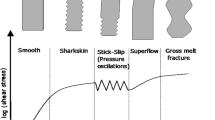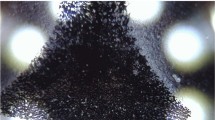Abstract
Rubber compounds are known to exhibit slip at the wall in particular flow conditions. The slip velocity is usually determined by using the classical Mooney method. The rheological behavior of a styrene butadiene rubber (SBR) compound was studied with three different rheometers. Biconical rotational, capillary and slit die rheometers were used to define the true viscous behavior of the compound and the slip velocity. It was shown that it was impossible to apply the Mooney method to our experimental data. New characterizations were thus developed for both capillary and slit die experiments. They were based on the dependency of the slip velocity on the local flow gap. Contrarily to the Mooney method, they provided physically acceptable results and led to a power-law relationship between wall slip, wall shear stress and local geometry of the flow.
Similar content being viewed by others
References
Badura R, Klüppel M, Schuster RH (1992) Interaction of rubber and softener and the effect on rheological data. J Appl Polym Sci, Appl Polym Symp 50:95–107
Blyler LL, Hart AC (1970) Capillary flow instability of ethylene polymer melts. Polym Eng Sci 10:193
Brzoskowski R, Kubota K, Chung K, White JL, Weissert FC, Nakajima N, Min K (1987) Experimental and theoretical study of the flow characteristics of rubber compounds in an extruder screw. Int Polym Proc 1:130–136
Chauffoureaux JC, Dehennau C, Van Rijckevorsel J (1979) Flow and thermal stability of rigid PVC. J Rheol 23:1
Decker GE, Roth FL (1953) Influence of variation in rotors, dies and rate of shear on Mooney viscosity. Indian Rubber World 128:339–343
El Kissi N, Piau JM (1989) Ecoulement de fluides polymères enchevétrés. Modélisation du glissement macroscopique à la paroi. CR Acad Sci Paris 309:7–9
Ertong S, Schümmer P (1980) On the rheological properties of rubber compounds containing different carbon black concentrations. In: Oliver DR (Ed) Third European Rheology Conference. Elsevier, London, p 153–155
Geiger K (1989) Rheologische Charakterisierung von EPDM Kautschukmischungen mittels Kapillar-Rheometer Systemen. Kautsch Gummi Kunstst 42:273–283
Hatzikiriakos SG, Dealy JM (1991) Wall slip of molten high density polyethylene. Sliding plate rheometer studies. J Rheol 35:497–523
Hatzikiriakos SG, Dealy JM (1992) Wall slip of molten high density polyethylene. Capillary rheometer studies. J Rheol 36:703–741
Jepsen C, Räbiger N (1988) Untersuchungen zum Wandgleitverhalten von Kautschukmischungen an einem Hochdruck-Kapillar-Viskometer. Kautsch Gummi Kunstst 41:342–352
Kalika DS, Denn MM (1987) Wall slip and extrudate distortion in linear low-density polyethylene. J Rheol 31:815–834
Kanu RC, Shaw MT (1982) Rheology of polymer blends: simultaneous slippage and entrance pressure loss in the EPDM/Viton system. Polym Eng Sci 22:507–511
Knappe W, Krümbock E (1986) Slip flow of non-plasticized PVC-compounds. Rheol Acta 25:296–307
Lau HC, Schowalter WR (1986) A model for adhesive failure of viscoelastic fluids during flow. J Rheol 30:193–206
Laun HM (1983) Polymer melt rheology with a slit die. Rheol Acta 22:171–185
Leblanc JL, Villemaire JP, Vergnes B, Agassant JF (1989) Effect of wall slippage on pressure drop in converging dies when extruding natural rubber compounds. Plast Rubber Proc Appl 11:53–57
Lupton JM, Regester JW (1965) Melt flow of polyethylene at high rates. Polym Eng Sci 5:235
Ma CY, White JL, Weissert FC, Isayev AI, Nakajima N, Min K (1985) Flow patterns in elastomers and their carbon black compounds during extrusion through dies. Rubber Chem Tech 58:815
Menges G, Wortberg J, Geisbüsch P, Targiel G (1981) Fließverhalten von Kautschukmischungen. Kautsch Gummi Kunstst 34:631–636
Mooney M (1931) Explicit formulas for slip and fluidity. J Rheol 2:210–222
Mooney M (1934) A shearing disk plastometer for unvulcanized rubber. Ind Eng Chem Anal Ed 6:147
Mooney M (1958) The Rheology of raw elastomers. In: Eirich FR (Ed) rheology: theory and applications. Academic Press, New York, p 181–233
Mourniac P (1991) Le problème du glissement à la paroi dans les ecoulements de mélanges d'elastomères. Ph D Dissertation, Ecole des Mines de Paris, Sophia-Antipolis
Natov M, Avramova J, Vassileva S (1980) Das Wandgleiten beim Fließen von Polymerschmelzen durch Kapillaren mit kreisförmigem Querschnitt. Rheol Acta 19:83–87
Ramamurthy AV (1986) Wall slip in viscous fluids and influence of materials of construction. J Rheol 30:337–357
Turner DM, Moore MD (1980) The contribution of wall slip in the flow of rubber. Plastics Rubber Proc 5:81–84
Uhland E (1976) Modell zur Beschreibung des Fließens wandgleitender Substanzen durch Düsen. Rheol Acta 15:30
Vergnes B, d'Halewyn S, Boube MF (1992) Wall slip and instabilities in the flow of EPDM compounds. XIth Int Congress on Rheology, Brussels
White JL, Han MH, Nakajima N, Brzoskowski R (1991) The influence of materials of construction on biconical rotor and capillary measurements of shear viscosity of rubber and its compounds and considerations of slippage. J Rheol 35:167–189
Wiegreffe S (1991) Untersuchungen zum Wandgleitverhalten von EPDM und SBR. Kautsch Gummi Kunstst 44:216–221
Worth RA, Parnaby J, Helmy HAA (1977) Wall slip and its implications in the design of single screw melt-fed extruders. Polym Eng Sci 17:257–265
Author information
Authors and Affiliations
Rights and permissions
About this article
Cite this article
Mourniac, P., Agassant, J.F. & Vergnes, B. Determination of the wall slip velocity in the flow of a SBR compound. Rheola Acta 31, 565–574 (1992). https://doi.org/10.1007/BF00367011
Received:
Revised:
Issue Date:
DOI: https://doi.org/10.1007/BF00367011




